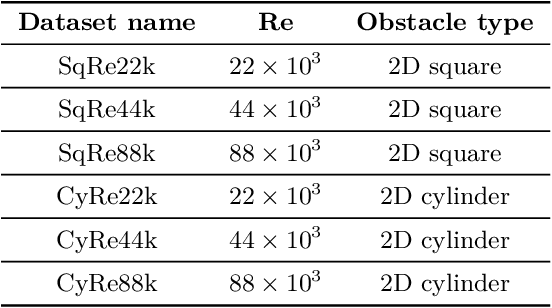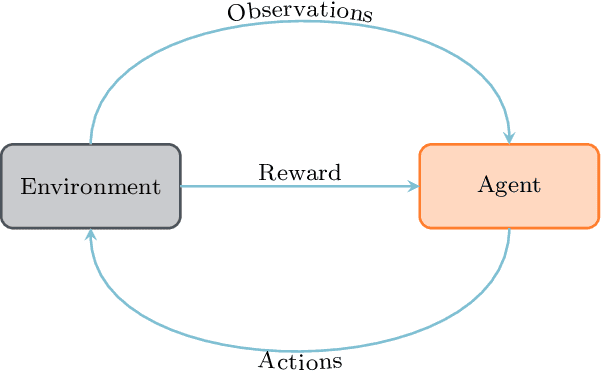Elie Hachem
MeshMask: Physics-Based Simulations with Masked Graph Neural Networks
Jan 15, 2025Abstract:We introduce a novel masked pre-training technique for graph neural networks (GNNs) applied to computational fluid dynamics (CFD) problems. By randomly masking up to 40\% of input mesh nodes during pre-training, we force the model to learn robust representations of complex fluid dynamics. We pair this masking strategy with an asymmetric encoder-decoder architecture and gated multi-layer perceptrons to further enhance performance. The proposed method achieves state-of-the-art results on seven CFD datasets, including a new challenging dataset of 3D intracranial aneurysm simulations with over 250,000 nodes per mesh. Moreover, it significantly improves model performance and training efficiency across such diverse range of fluid simulation tasks. We demonstrate improvements of up to 60\% in long-term prediction accuracy compared to previous best models, while maintaining similar computational costs. Notably, our approach enables effective pre-training on multiple datasets simultaneously, significantly reducing the time and data required to achieve high performance on new tasks. Through extensive ablation studies, we provide insights into the optimal masking ratio, architectural choices, and training strategies.
Multi-Grid Graph Neural Networks with Self-Attention for Computational Mechanics
Sep 18, 2024



Abstract:Advancement in finite element methods have become essential in various disciplines, and in particular for Computational Fluid Dynamics (CFD), driving research efforts for improved precision and efficiency. While Convolutional Neural Networks (CNNs) have found success in CFD by mapping meshes into images, recent attention has turned to leveraging Graph Neural Networks (GNNs) for direct mesh processing. This paper introduces a novel model merging Self-Attention with Message Passing in GNNs, achieving a 15\% reduction in RMSE on the well known flow past a cylinder benchmark. Furthermore, a dynamic mesh pruning technique based on Self-Attention is proposed, that leads to a robust GNN-based multigrid approach, also reducing RMSE by 15\%. Additionally, a new self-supervised training method based on BERT is presented, resulting in a 25\% RMSE reduction. The paper includes an ablation study and outperforms state-of-the-art models on several challenging datasets, promising advancements similar to those recently achieved in natural language and image processing. Finally, the paper introduces a dataset with meshes larger than existing ones by at least an order of magnitude. Code and Datasets will be released at https://github.com/DonsetPG/multigrid-gnn.
Beacon, a lightweight deep reinforcement learning benchmark library for flow control
Feb 27, 2024Abstract:Recently, the increasing use of deep reinforcement learning for flow control problems has led to a new area of research, focused on the coupling and the adaptation of the existing algorithms to the control of numerical fluid dynamics environments. Although still in its infancy, the field has seen multiple successes in a short time span, and its fast development pace can certainly be partly imparted to the open-source effort that drives the expansion of the community. Yet, this emerging domain still misses a common ground to (i) ensure the reproducibility of the results, and (ii) offer a proper ad-hoc benchmarking basis. To this end, we propose Beacon, an open-source benchmark library composed of seven lightweight 1D and 2D flow control problems with various characteristics, action and observation space characteristics, and CPU requirements. In this contribution, the seven considered problems are described, and reference control solutions are provided. The sources for the following work are available at https://github.com/jviquerat/beacon.
Robust deep learning for emulating turbulent viscosities
Oct 01, 2021



Abstract:From the simplest models to complex deep neural networks, modeling turbulence with machine learning techniques still offers multiple challenges. In this context, the present contribution proposes a robust strategy using patch-based training to learn turbulent viscosity from flow velocities, and demonstrates its efficient use on the Spallart-Allmaras turbulence model. Training datasets are generated for flow past two-dimensional (2D) obstacles at high Reynolds numbers and used to train an auto-encoder type convolutional neural network with local patch inputs. Compared to a standard training technique, patch-based learning not only yields increased accuracy but also reduces the computational cost required for training.
A review on Deep Reinforcement Learning for Fluid Mechanics
Aug 12, 2019



Abstract:Deep reinforcement learning (DRL) has recently been adopted in a wide range of physics and engineering domains for its ability to solve decision-making problems that were previously out of reach due to a combination of non-linearity and high dimensionality. In the last few years, it has spread in the field of computational mechanics, and particularly in fluid dynamics, with recent applications in flow control and shape optimization. In this work, we conduct a detailed review of existing DRL applications to fluid mechanics problems. In addition, we present recent results that further illustrate the potential of DRL in Fluid Mechanics. The coupling methods used in each case are covered, detailing their advantages and limitations. Our review also focuses on the comparison with classical methods for optimal control and optimization. Finally, several test cases are described that illustrate recent progress made in this field. The goal of this publication is to provide an understanding of DRL capabilities along with state-of-the-art applications in fluid dynamics to researchers wishing to address new problems with these methods.
 Add to Chrome
Add to Chrome Add to Firefox
Add to Firefox Add to Edge
Add to Edge